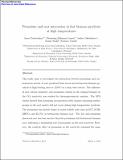| dc.contributor.author | Trubetskaya, Anna | |
| dc.contributor.author | Larsen, Flemming Hofmann | |
| dc.contributor.author | Shchukarev, Andrey | |
| dc.contributor.author | Ståhl, Kenny | |
| dc.contributor.author | Umeki, Kentaro | |
| dc.date.accessioned | 2018-05-16T10:29:26Z | |
| dc.date.issued | 2018-04-02 | |
| dc.identifier.citation | Trubetskaya, A., Larsen, F. H., Shchukarev, A., Ståhl, K., & Umeki, K. (2018). Potassium and soot interaction in fast biomass pyrolysis at high temperatures. Fuel, 225, 89-94. doi: https://doi.org/10.1016/j.fuel.2018.03.140 | en_IE |
| dc.identifier.issn | 1873-7153 | |
| dc.identifier.uri | http://hdl.handle.net/10379/7361 | |
| dc.description.abstract | This study aims to investigate the interaction between potassium and carbonaceous matrix of soot produced from wood and herbaceous biomass pyrolysis at high heating rates at 1250°C in a drop tube reactor. The influence of soot carbon chemistry and potassium content in the original biomass on the CO2 reactivity was studied by thermogravimetric analysis. The XPS results showed that potassium incorporation with oxygen-containing surface groups in the soot matrix did not occur during high temperature pyrolysis. The potassium was mostly found as water-soluble salts such as KCl, KOH, KHCO3 and K2CO3 in herbaceous biomass soot. The low ash-containing pinewood soot was less reactive than the potassium rich herbaceous biomass soot, indicating a dominating role of potassium on the soot reactivity. However, the catalytic effect of potassium on the reactivity remained the same after a certain potassium amount was incorporated in the soot matrix during pyrolysis. Raman spectroscopy results showed that the carbon chemistry of biomass soot also affected the CO2 reactivity. The less reactive pinewood soot was more graphitic than herbaceous biomass soot samples with the disordered carbon structure. | en_IE |
| dc.description.sponsorship | The authors gratefully acknowledge financial support from the Kempe Foundation, the Swedish Energy Agency and the Swedish strategic research program Bio4Energy. The authors acknowledge the facilities and technical support of Dr. Nikki Lee of the Umeå Core Facility for Electron Microscopy (UCEM) at the Chemical and Biological Centre (KBC), Dr. Andras Gorzsas, Dr. Nils Skoglund and Dr. Markus Broström at Umeå University. We acknowledge Avery Brown from Worcester Polytechnic Institute for the article proof-reading. | en_IE |
| dc.format | application/pdf | en_IE |
| dc.language.iso | en | en_IE |
| dc.publisher | Elsevier | en_IE |
| dc.relation.ispartof | Fuel | en |
| dc.rights | Attribution-NonCommercial-NoDerivs 3.0 Ireland | |
| dc.rights.uri | https://creativecommons.org/licenses/by-nc-nd/3.0/ie/ | |
| dc.subject | Soot | en_IE |
| dc.subject | Potassium | en_IE |
| dc.subject | Biomass | en_IE |
| dc.subject | Fast pyrolysis | en_IE |
| dc.subject | CO2 reactivity | en_IE |
| dc.title | Potassium and soot interaction in fast biomass pyrolysis at high temperatures | en_IE |
| dc.type | Article | en_IE |
| dc.date.updated | 2018-05-08T17:47:01Z | |
| dc.identifier.doi | 10.1016/j.fuel.2018.03.140 | |
| dc.local.publishedsource | https://doi.org/10.1016/j.fuel.2018.03.140 | en_IE |
| dc.description.peer-reviewed | peer-reviewed | |
| dc.description.embargo | 2020-04-02 | |
| dc.internal.rssid | 14302865 | |
| dc.local.contact | Anna Trubetskaya, Mechanical Engineering, College Of Engineering And Informatics, Nui Galway. - Email: anna.trubetskaya@nuigalway.ie | |
| dc.local.copyrightchecked | No | |
| dc.local.version | PUBLISHED | |
| nui.item.downloads | 169 | |


